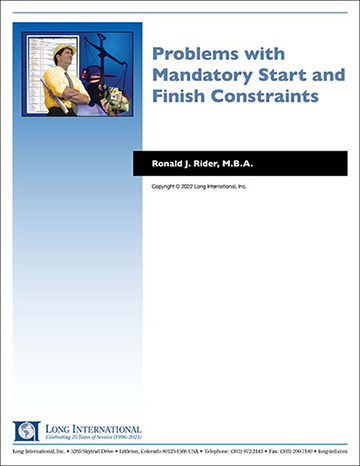
Problems with Mandatory Start and Finish Time Constraints in Projects
The use of mandatory start and finish time constraints during projects is discouraged in the construction scheduling industry. The purpose of this article is to promote awareness and discussion regarding problems created when using mandatory schedule constraints as well as to recommend more reasonable constraint type alternatives.
1. INTRODUCTION
A critical path method (CPM) schedule or programme is a dynamic planning tool that engineering and construction industry planners and schedulers commonly use to manage, coordinate, and forecast work activities based on activity durations and logic. It is paramount that a CPM schedule accurately calculate forecasted dates for work activities contained in the schedule. Planners and schedulers commonly apply date constraints to work activities or milestone activities in a CPM schedule to represent contractually required completion dates for either intermediate milestone activities or an overall project finish date.1
A planner or scheduler may also apply date constraints to represent crucial need dates, such as the completion of issued-for-construction drawings, shipment of long-lead equipment, customs clearance, delivery of equipment and materials to a project site, start of field installation, completion of foundations, erection of structural steel, fabrication of process pipe, mounting of instruments, area or system turnover, mechanical completion, or ready-for-startup tasks. During project execution, this insertion of date constraints allows planners and schedulers to gauge schedule progress relative to the date-constrained work activities.
Commercially available critical path method scheduling programs, such as Oracle Primavera (P6), provide nine constraint types to use in a schedule, as listed in Table 1-1 below.
Table 1-1: Listing of Available P6 Constraint Types
| Item No. | Constraint Type | Constraint Category |
|---|---|---|
| 1 | Start-On Constraint | Soft Constraint |
| 2 | Start-On-Or-After Constraint | Soft Constraint |
| 3 | Start-On-Or-Before Constraint | Soft Constraint |
| 4 | Finish-On Constraint | Soft Constraint |
| 5 | Finish-On-Or-After Constraint | Soft Constraint |
| 6 | Finish-On-Or-Before Constraint | Soft Constraint |
| 7 | As-Late-As-Possible (“ALAP”) Constraint | Soft Constraint |
| 8 | Mandatory Start Constraint | Hard Constraint |
| 9 | Mandatory Finish Constraint | Hard Constraint |
As identified above, most of the P6 project schedule constraint types, i.e., item numbers 1 through 7, are commonly categorized as soft constraints that allow schedule logic to be maintained and prioritized over the constraint date. In contrast, for item numbers 8 and 9, mandatory constraint types are commonly categorized as hard constraints. Hard constraints are unique in that the hard constraint date takes priority over schedule logic. Consequently, if a hard date constraint takes priority over the planned schedule logic flow, then the determination of true critical and near-critical paths may not be properly calculated.
Therefore, it is not surprising that the use of mandatory start and finish constraints is discouraged in the construction scheduling industry. Although planners and schedulers are not barred from using mandatory start and finish constraints, these constraints may artificially change the critical path, make proper examination of float values difficult, interrupt a continuous path through work activities, and cause differing float values from one activity to the next activity within a given logic chain. For these reasons, the use of mandatory schedule constraints can be problematic, especially when a planner or scheduler is required to report the real driving critical path as well as accurately forecasted completion dates to stakeholders, or when parties are trying to accurately quantify or prove schedule delay.
The purpose of this article is to promote awareness and discussion regarding problems created when using mandatory constraints as well as to recommend more reasonable constraint type alternatives.
2. WHAT ARE MANDATORY SCHEDULE CONSTRAINTS IN PROJECT MANAGEMENT?
In CPM scheduling, mandatory start and finish constraints are generally defined as imposed date restrictions applied to either the start date or finish date of a task activity or milestone activity. The key feature, as well as the most problematic, is that mandatory start and finish constraints override existing CPM schedule logic and force the early dates and/or late dates to equal the mandatory constraint date. Mandatory constraints can cause differing float values to predecessor or successor activities within a logic chain, thus causing confusion when trying to determine the true critical path.
Even if predecessor activity forecasted dates are later than an imposed mandatory constraint date, the predecessor logic links are ignored by the mandatory constraint. Intuitively, it does not make logical sense to start work before the preceding work is finished based on the planned logic. It becomes more problematic if a schedule contains thousands of work activities and has numerous mandatory constraints throughout the schedule. A schedule with even very few mandatory constraints applied to task or milestone activities can create confusion regarding the critical path and/or near-critical paths.
Mandatory schedule constraints could create conditions that can cause work activities within a driving critical path chain to have negative, positive, and/or zero total float values. Some stakeholders are unfamiliar with how mandatory constraints can calculate forecasted dates and total float values. Differing float values on driving critical path activities could cause such stakeholders to wrongly conclude that an activity is behind or ahead of schedule.
Therefore, many scheduling practitioners along with several recognized industry publications discourage the use of mandatory constraints. For instance, AACE International’s Recommended Practice (RP) 49R-06, titled “Identifying the Critical Path,” states:
This type of constraint forces a start or finish date to be observed even if CPM logic otherwise forbids the occurrence. This RP strongly recommends against the use of mandatory constraints as they lead to illogical results where activities are scheduled to occur even if preceding work is incomplete.2
Similarly, the U.S. Government Accountability Office (GAO) Schedule Assessment Guide: Best Practices for Project Schedules, discourages the use of mandatory constraints. The GAO uses the acronym MSON to define a Mandatory Start constraint and the acronym MFON for a Mandatory Finish constraint. The GAO states:
Because MSON and MFON constraints prevent activities not only from slipping but also from accelerating, their use is discouraged. They should never appear in the schedule baseline. If not properly justified in working schedules, they must be immediately questioned.3
3. PROBLEMS WITH MANDATORY START CONSTRAINTS
To illustrate the problem created when using mandatory start constraints, Figure 3-1 below presents a simple P6 bar chart schedule that summarizes the as-planned schedule of a group of task activities and milestones. The schedule is free of constraints and has a data date of 1 April 2021. The critical path starts with Activity ID ACT A, “Start Project – Start Milestone.” Based on the durations and logic of successor activities, the critical path traces from ACT A through the project completion activity shown by ACT H, “Project Complete – Finish Milestone.” ACT H has a forecasted overall finish date of 21 October 2021. The early dates and late dates for all activities are the same with float equal to zero. Thus, the project is planned to finish on 21 October 2021.
Figure 3‑1: Simple As-Planned P6 Bar Chart

In Figure 3-2 below, a 16 August 2021 mandatory start constraint was applied to ACT E, “Required-On-Site (ROS).” The imposed mandatory start constraint forced ACT E’s early and late dates to be 16 August 2021. When compared to the 3 September 2021 original forecasted start and finish date, ACT E’s 16 August 2021 mandatory start constraint date is 14 workdays or 18 calendar days earlier than 3 September 2021, and ACT E’s total float value is artificially forced to be zero workdays.
Figure 3‑2: Simple As-Planned Bar Chart with a Mandatory Start Constraint

As shown above, ACT E’s immediate predecessor, ACT D, “Fabrication/Delivery,” has a calculated early finish date of 2 September 2021. Based on early dates, it is reasonable to conclude that ACT E cannot start any earlier than 3 September 2021, which is the next day after ACT D’s early finish date of 2 September 2021. Table 3-1 highlights the interrupted logic problem between ACT D and ACT E.
Table 3‑1: Problem Created between ACT D and ACT E Due to a Mandatory Start Constraint Applied to ACT E
| Activity ID | Description | Logic Link | OD in Workdays | Early Start Date | Early Finish Date | Total Float in Workdays | Applied Constraint |
|---|---|---|---|---|---|---|---|
| ACT D | Fabrication/Delivery | 60 | 11JUN21 | 02SEP21 | -14 | ||
| Logic Link between ACT D and ACT E | Finish-to-Start with zero-day lag (i.e., FS 0) | ||||||
| ACT E | Required-On-Site (ROS) | 1 | 16AUG21 | 16AUG21 | 0 | Mandatory Start of 16AUG21 |
The mandatory start constraint applied to ACT E overrides the predecessor finish-to-start logic link from the ACT D fabrication and delivery work. The mandatory start constraint permits ACT E to start on 16 August 2021, even though the delivery activity will not occur until 2 September 2021. How is it possible to install equipment when the equipment is forecasted to be delivered 14 workdays later? This does not make logical sense.
In Figure 3-2 above, the mandatory start constraint applied to ACT E also affects the total float values of ACT E’s predecessor logic chain. The late finish date of the fabrication and delivery predecessor ACT D is calculated to be 13 August 2021. When comparing ACT D’s forecasted 2 September 2021 early finish date to its 13 August 2021 forecasted late finish date, ACT D’s total float value is negative 14 workdays. In fact, ACT E’s entire predecessor chain shows negative 14 workdays of total float directly caused by the 16 August 2021 mandatory start constraint that was applied to ACT E.
In contrast, the forecasted dates and float values to ACT E’s successor logic chain are affected differently. For example, the early start date of the immediate successor ACT F, “Installation/Construction and Precommissioning,” is forecasted to start on 16 August 2021, which is the same day as ACT E’s 16 August 2021 mandatory start constraint date.4 ACT F’s forecasted 16 August 2021 early start date and 24 September 2021 early finish date are 14 workdays earlier than its original 3 September 2021 late start date and 14 October 2021 late finish date as shown in Figure 3‑1. The difference in early and late dates for ACT F shows available float of 14 workdays. Table 3-2 highlights the positive total float generated between ACT E and ACT F.
Table 3‑2: Positive Float Generated between ACT E and ACT F Due to a Mandatory Start Constraint Applied to ACT E
| Activity ID | Description | Logic Link | OD in Workdays | Early Start Date | Early Finish Date | Total Float in Workdays | Applied Constraint |
|---|---|---|---|---|---|---|---|
| ACT E | Required-On-Site (ROS) | 1 | 16AUG21 | 16AUG21 | 0 | Mandatory Start of 16AUG21 | |
| Logic Link between ACT E and ACT F | Start-to-Start with zero-day lag (i.e., SS 0) | ||||||
| ACT F | Installation/Construction and Precommissioning | 30 | 16AUG21 | 24SEP21 | 14 |
In fact, each of ACT E’s successor logic chain work activities (i.e., ACTs F, G, and H) shows 14 workdays of positive float. This is inconsistent with the negative 14 workdays of float calculated for ACT E’s predecessor logic chain activities (i.e., ACTs A, B, C, and D). Figure 3-3 is a graphical comparison of the schedule with no constraints and the schedule with the applied mandatory start constraint.
Figure 3‑3: Comparison of Simple As-Planned P6 Bar Chart to Mandatory Start Constraint
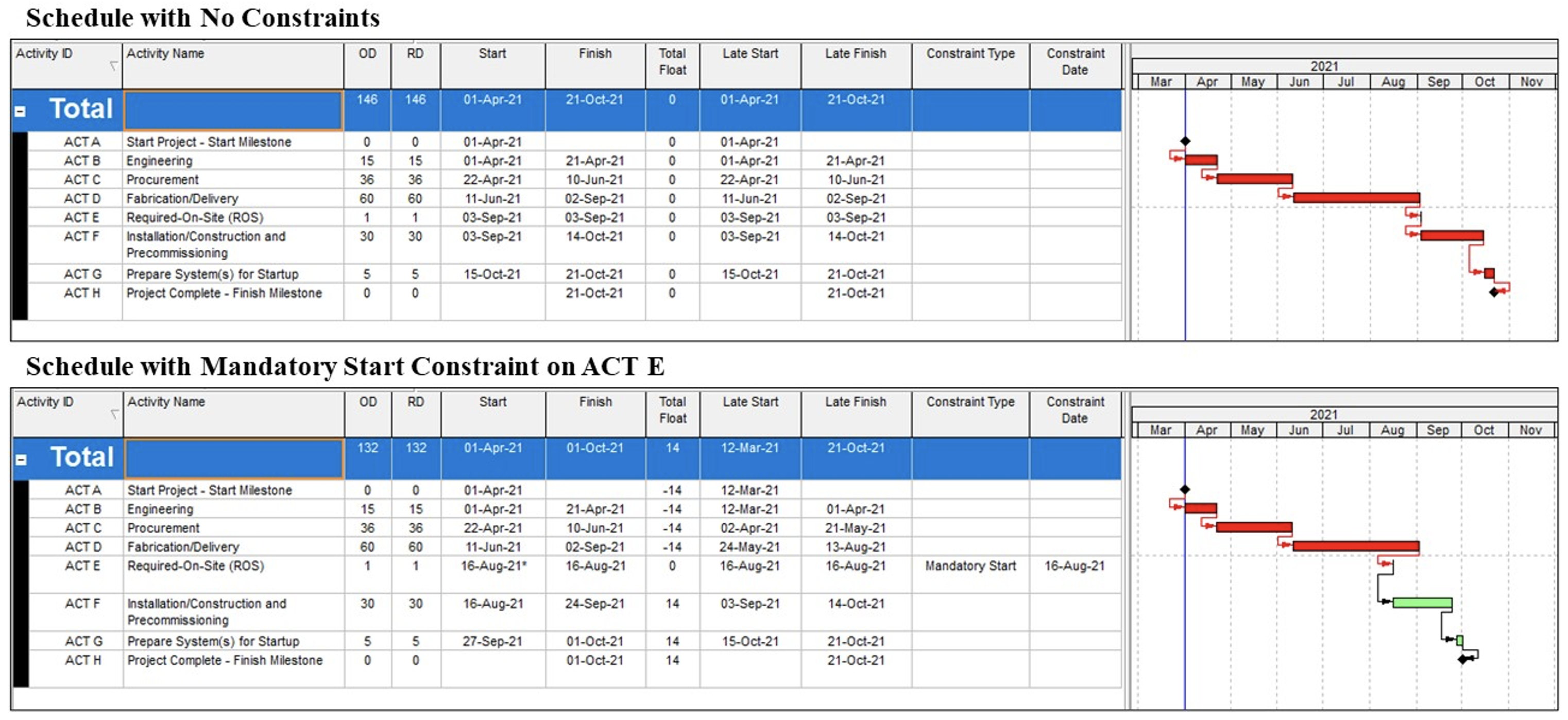
The 16 August 2021 mandatory start constraint date that is applied to ACT E causes its predecessor logic chain to have negative 14 workdays of float, while ACT E’s successor logic chain has 14 workdays of available float. The mandatory start constraint on ACT E artificially accelerates the installation, construction, precommissioning, startup, and overall completion work by 14 workdays. Based on early dates, the schedule calculates a 1 October 2021 overall completion date per ACT H, which is questionable given the fact that ACT E should not be able to start until its immediate predecessor ACT D is complete on 2 September 2021.
3.1 RECOMMENDED ALTERNATIVES TO MANDATORY START CONSTRAINTS
A preferable alternative to a mandatory project schedule start constraint is a constraint type that enforces an imposed start date but also maintains logic integrity even if predecessor activities have forecasted early dates earlier or later than the mandatory start constraint date. Within the P6 scheduling program, the constraint types that meet this definition are the start-on and start-on-or-before constraint types, which are summarized in Table 3-3 below.
Table 3‑3: Alternate Start Constraint Types Defined in P6
| Constraint Type | Constraint Definition5 |
|---|---|
| Start-On Constraint | A restriction you place on an activity by imposing a start date. The start on constraint can delay an early start or accelerate a late start to satisfy the imposed date. Unlike the mandatory start constraint, which can violate the network logic, this constraint protects it. |
| Start-On-Or-Before Constraint | A restriction you impose on an activity that limits the latest date it can start. When calculating a schedule, the start on or before constraint is used in the backward pass only if the calculated late start date will be later than the imposed date. This constraint may decrease total float. It only affects late dates. |
Both the start-on and start-on-or-before constraints restrict the start of an activity to the specified start constraint date. Yet, if a predecessor’s early dates are later than the start constraint date (i.e., the predecessor is delayed), then the early dates for the activity containing either a start-on or a start-on-or-before constraint are driven by the delayed predecessor’s early dates, thereby maintaining the logic integrity. Figure 3-4 displays alternative start constraint types on ACT E by using start-on and start-on-or-before constraints.
Figure 3‑4: Alternative Start Constraint on ACT E
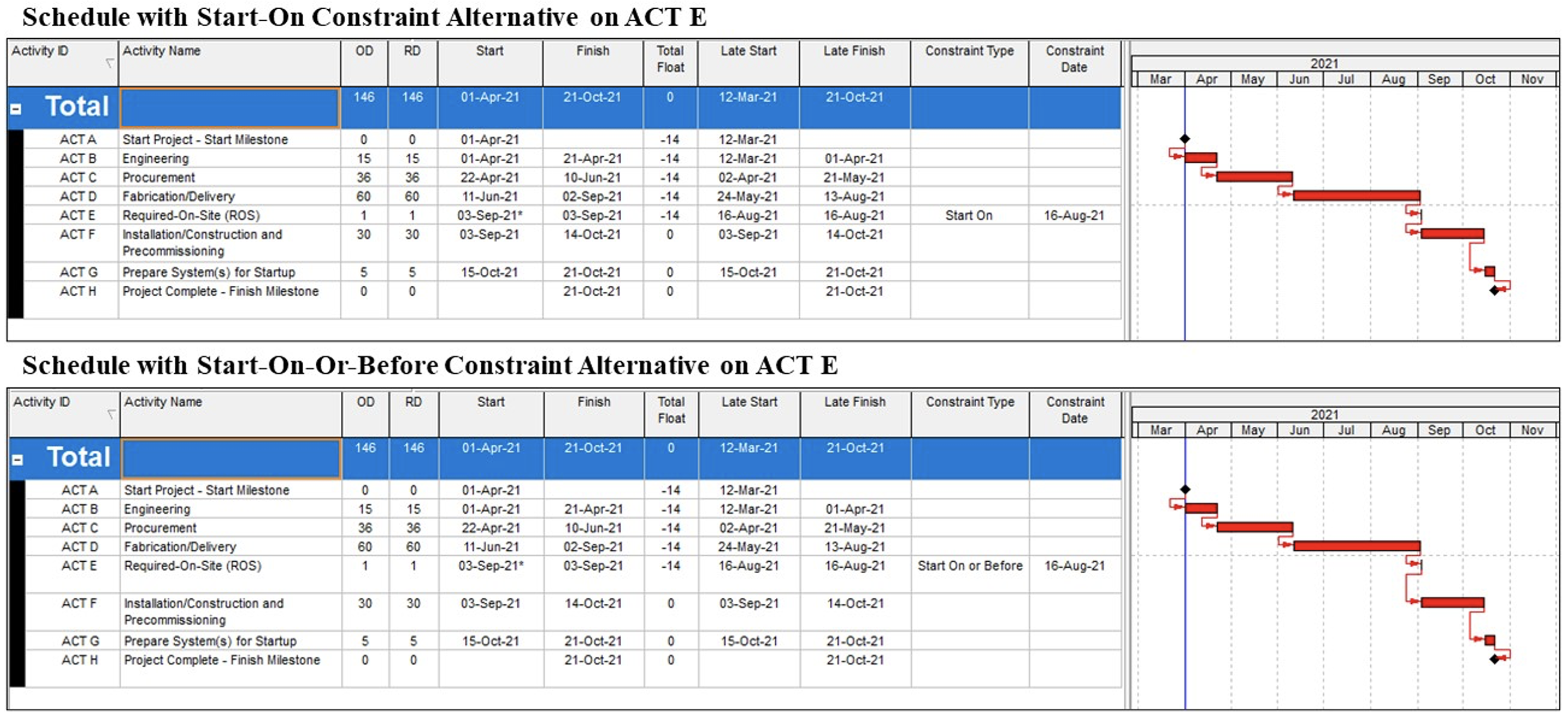
Both the 16 August 2021 start-on and start-on-or-before constraints affect only the late start date on ACT E instead of its early start date. As a result, ACT E’s 3 September 2021 early start date is driven by the 2 September 2021 early finish date of its immediate predecessor ACT D. Even though ACT E’s start-on and start-on-or-before constraint date is 16 August 2021, which is causing ACT E to have negative 14 calendar days of total float, the logic link between ACT D and ACT E is accurately maintained.6
Moreover, the early dates for ACT E’s successor activities are also driven by ACT E’s correctly calculated 3 September 2021 early start date. Except for the negative 14 workdays of total float for activities ACT A through ACT E, the forecasted early dates for ACT E’s successor activities ACT F, ACT G, and ACT H are the same forecasted early dates and late dates compared to the schedule free of all constraints. Figure 3-5 is a summary comparison between a schedule with no constraints and a schedule using start-on and start-on-or-before constraints applied to ACT E.
Figure 3‑5: Comparison of Schedules Using Alternate Start Constraints on ACT E
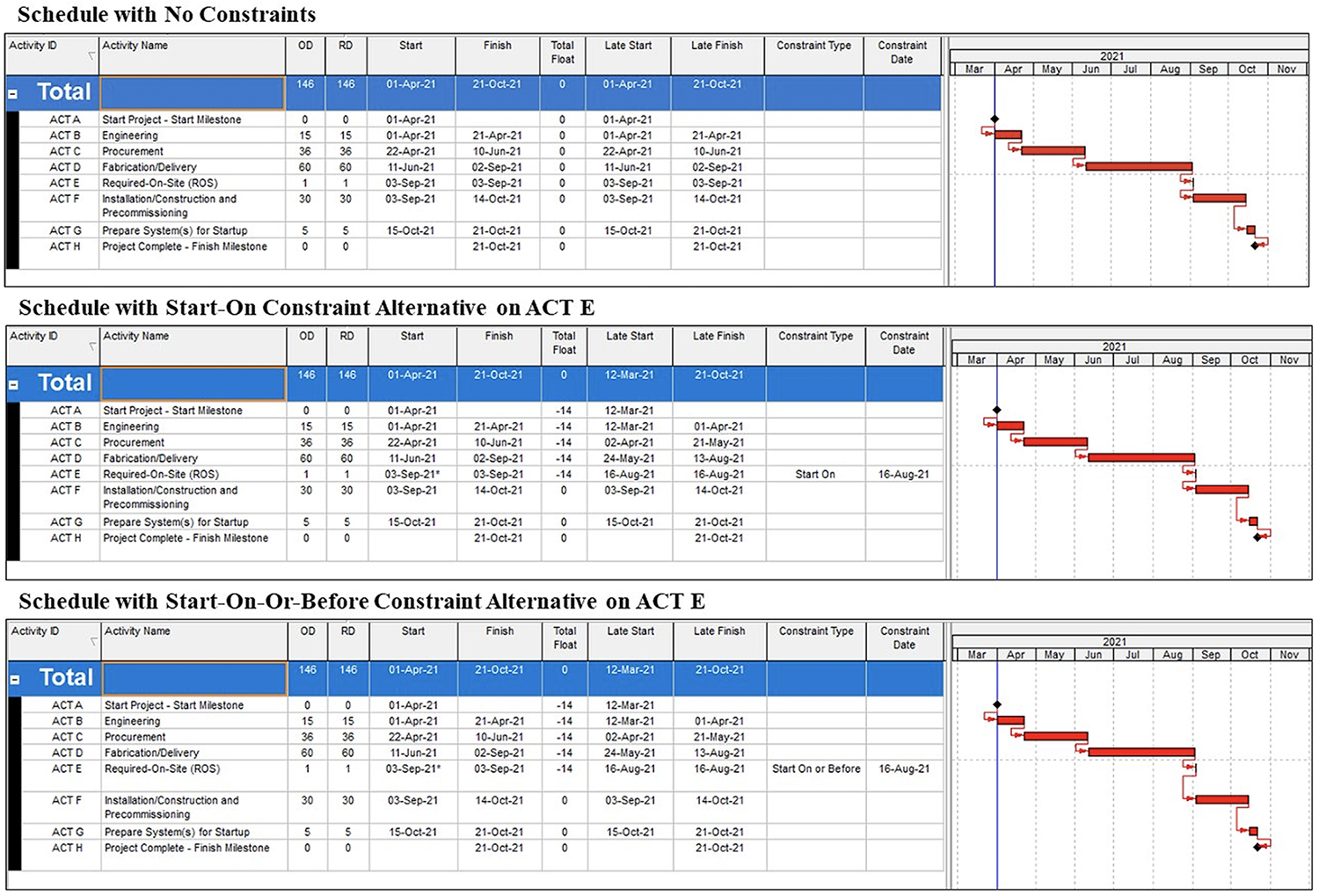
Although ACT E and its predecessor logic chain of work activities show negative 14 workdays of total float when using start-on and start-on-or-before constraints, the schedule logic is preserved with correctly calculated forecasted early dates based on predecessor logic. The forecasted early dates are the same forecasted dates as calculated in the schedule with no constraints. Based on the above, start-on and start-on-or-before constraints are more reasonable constraint alternatives compared to the more restrictive and less flexible mandatory start constraint.
4. PROBLEMS WITH MANDATORY FINISH CONSTRAINTS
Similar to a mandatory start constraint, a mandatory finish constraint is a date constraint applied to an activity’s finish. It sets an activity’s early finish date and late finish date equal to a specified mandatory finish constraint date, and its total float value is set to zero. When a schedule is calculated, the mandatory finish constraint date is used irrespective of schedule logic. A mandatory finish constraint directly affects predecessor activity late dates that are linked to the activity with a mandatory finish constraint. Further, a mandatory finish constraint affects the constrained activity’s successor activity early dates.
All predecessor logical relationships to the mandatory finish constrained activity are ignored even if its logical predecessor activity should push it beyond the constrained date. To demonstrate this problem, a mandatory finish constraint was added to the schedule that also contained a mandatory start date on ACT E, as referenced earlier in Figure 3-2. The finish of ACT G, “Prepare System(s) for Startup,” was date constrained on 18 September 2021 by a mandatory finish constraint date.
After the schedule is recalculated, the inclusion of a mandatory finish constraint further worsens and disrupts the logic flow among work activities along the logic chain, and the reliability of forecasted dates becomes further compromised. Figure 4-1 below is a graphical comparison of the schedule with only a mandatory start constraint on ACT E compared to a schedule that contains both the mandatory start constraint on ACT E and a mandatory finish constraint to the finish of ACT G.
Figure 4‑1: Comparison of Simple As-Planned P6 Bar Chart with Mandatory Finish Constraint
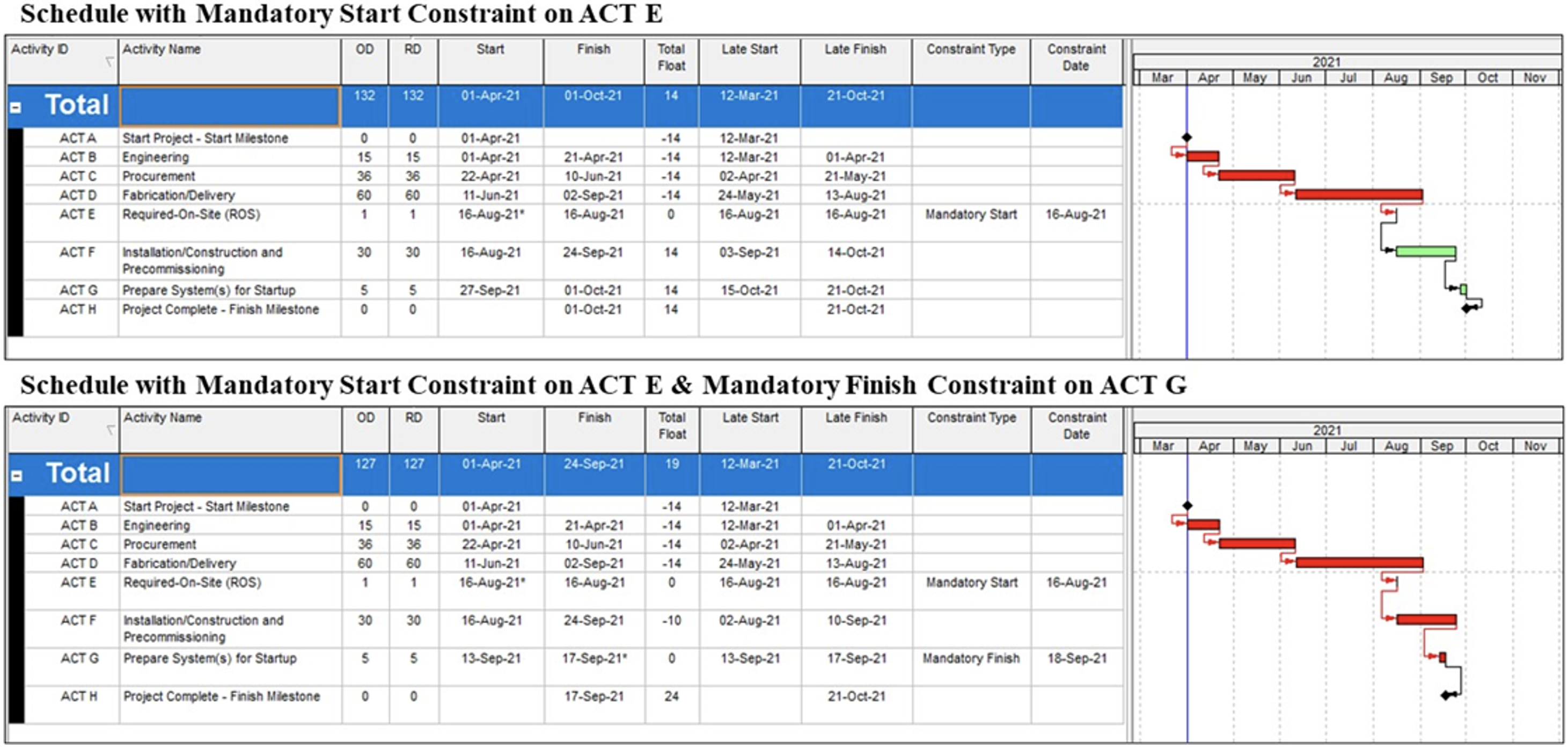
The applied mandatory finish constraint causes ACT G’s forecasted early and late dates both to be artificially set to 13 September 2021 and 17 September 2021, respectively. Both the early and late dates for ACT G are the same. Thus, ACT G’s total float value is set to zero. Moreover, the imposed mandatory finish constraint on ACT G decouples the predecessor finish-to-start logic link from its immediate predecessor ACT F, “Installation/Construction and Precommissioning.” Table 4-1 underscores the illogical work sequence created between ACT F and ACT G.
Table 4‑1: Problem Created between ACT F and ACT G Due to Mandatory Finish Constraint Applied to ACT G
| Activity ID | Description | Logic Link | OD in Workdays | Early Start Date | Early Finish Date | Total Float in Workdays | Applied Constraint |
|---|---|---|---|---|---|---|---|
| ACT F | Installation/Construction and Precommissioning | 30 | 16AUG21 | 24SEP21 | -10 | ||
| Logic Link between ACT F and ACT G | Finish-to-Start with zero-day lag (i.e., FS 0) | ||||||
| ACT G | Prepare System(s) for Startup | 5 | 13SEP21 | 17SEP217 | 0 | Mandatory Finish of 18SEP21 |
Although ACT G’s immediate predecessor ACT F has a 24 September 2021 forecasted early finish date, the mandatory finish applied to ACT G allows ACT G to start and finish before the finish of ACT F. However, it is not possible to start and finish the work needed for preparation of systems for startup contained in ACT G when the installation/construction and precommissioning scope within ACT F is forecasted to be completed seven calendar days later than the finish of ACT G.
In addition, the mandatory finish constraint date improperly affects the forecasted date and float value of ACT G’s immediate successor ACT H, “Project Complete – Finish Milestone.” Due to a finish-to-finish logic link from the finish of ACT G to ACT H, ACT H is forecasting a 17 September 2021 early finish date, which is the same date as the finish for ACT G. Relative to the unconstrained as-planned schedule, as shown in Figure 3-1, forecasted to finish on 21 October 2021, the constrained schedule calculates a positive total float value of 24 workdays for ACT H. To further illustrate the illogical work sequences imposed by the mandatory start and finish constraints, Table 4‑2 summarizes the forecasted dates and total float values calculated among ACTs F, G, and H.
Table 4‑2: Forecasted Dates and Float Values Calculated between ACT F, ACT G, and ACT H
| Activity ID | Description | Logic Link | OD in Workdays | Early Start Date | Early Finish Date | Total Float in Workdays | Applied Constraint |
|---|---|---|---|---|---|---|---|
| ACT F | Installation/Construction and Precommissioning | 30 | 16AUG21 | 24SEP21 | -10 | ||
| Logic Link between ACT F and ACT G | Finish-to-Start with zero-day lag (i.e., FS 0) | ||||||
| ACT G | Prepare System(s) for Startup | 5 | 13SEP21 | 17SEP21 | 0 | Mandatory Finish of 18SEP21 | |
| Logic Link between ACT G and ACT H | Finish-to-Finish with zero-day lag (i.e., FF 0) | ||||||
| ACT H | Project Complete – Finish Milestone | 0 | 17SEP21 | 24 |
As shown in the table above, the imposed 18 September 2021 mandatory finish constraint date that was applied to ACT G creates several problems for the ACT F, G, and H logic chain. First, all three activities have three differing total values. ACT F has a total float value of negative 10 workdays. ACT G is showing zero total float, while its successor ACT H has 24 workdays of available total float. The total float values for these three logically sequenced activities should be consistent. The calculated total float values are inconsistent and illogical.
Second, the overall project completes earlier than the completion of predecessor work, which is not possible. ACT H’s early finish date is 17 September 2021, which is seven calendar days earlier than the early finish of the installation and precommissioning ACT F. It is not reasonable to forecast the overall completion date a week earlier than required predecessor work.
Last, project stakeholders who are unfamiliar with CPM details or effects from imposed mandatory constraints within the schedule may mistakenly conclude that the overall project will finish early. When comparing the forecasted 21 October 2021 overall finish date from the schedule without mandatory constraints (i.e., Figure 3-1) to the forecasted 17 September 2021 overall finish date as noted for ACT H in Table 4-2, a project stakeholder may incorrectly believe overall finish can be completed 34 calendar days early (i.e., 21 October 2021 versus 17 September 2021). Project stakeholder planning and financial decisions may be inappropriately based on an unachievable early completion forecast of 17 September 2021, due to the misuse of mandatory constraints.
4.1 RECOMMENDED ALTERNATIVES TO MANDATORY FINISH CONSTRAINTS
Alternatives to a mandatory finish constraint allow for the enforcement of an imposed constraint date but also allow for maintaining logic flow between work activities. Even if predecessor activities have forecasted dates later than the applied constraint date, alternative finish constraints accurately forecast activity dates based on the logic between work activities. Within the P6 scheduling program, the constraint types that meet this definition include finish-on and finish-on-or-before constraint types, identified in Table 4‑3 below.
Table 4‑3: Alternate Finish Constraint Types Defined in P6
| Constraint Type | Constraint Definition8 |
|---|---|
| Finish-On Constraint | A restriction you place on an activity by imposing a finish date. The finish-on constraint can delay an early finish or accelerate a late finish to satisfy the imposed date. |
| Finish-On-Or-Before Constraint | A restriction you impose on an activity that limits the latest time it can be finished. The finish-on-or-before constraint affects only late dates. Use this constraint to ensure that the late finish date of an activity is not later than the date you impose. |
Based on the definitions in the table above, both the finish-on and finish-on-or-before constraints are better alternatives to mandatory finish constraints. If a predecessor’s early dates are later than the finish constraint date, the early dates for the activity containing either a finish-on or finish-on-or-before constraint are calculated by the predecessor’s early dates. Thus, the integrity of logic flow is preserved. However, because the late finish date is constrained, a predecessor delay later than the late finish constraint date will generate negative float, which is an indication of a problem needing resolution. Figure 4-2 displays alternative start-on and start-on-or-before constraint types on ACT E and finish-on and finish-on-or-before constraints on ACT G.
Figure 4‑2: Comparison of Alternative Start and Finish Constraints
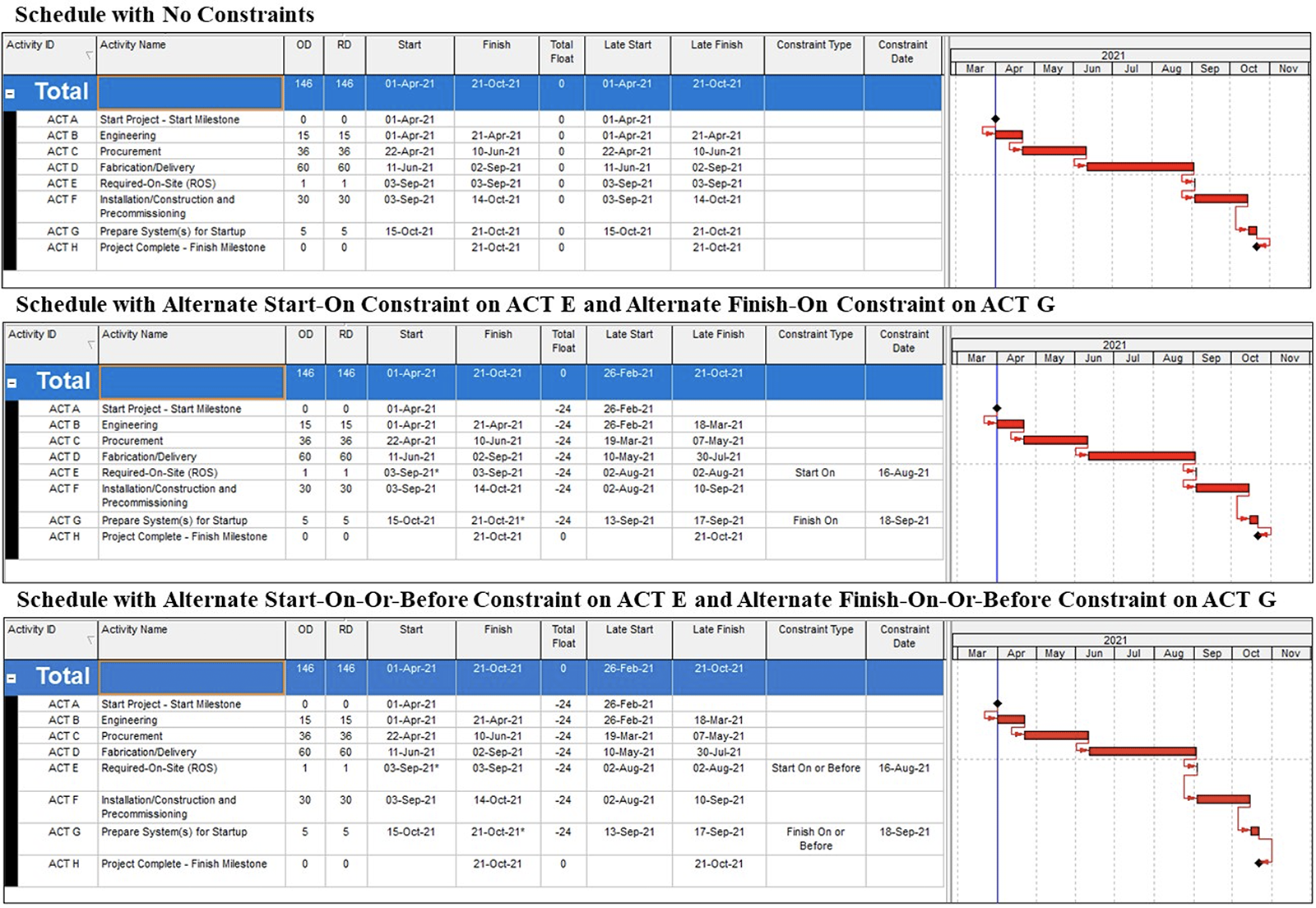
When employing the alternative start-on, start-on-or-before, finish-on, and finish-on-or-before constraints, the forecasted early dates and corresponding total float values are consistent and accurately maintain the planned logic between work activities. Even though the late dates for activities ACT A through ACT G show negative 24 workdays of total float due to the alternative constraint types, the alternative constraint types calculate the same forecasted early dates as compared to the schedule without constraints.
Using start-on, start-on-or-before, finish-on, and finish-on-or-before constraints avoids potentially illogical work sequences and inconsistently calculated float values caused by mandatory start and finish constraints. For the above example, a project stakeholder may wish to investigate the basis for constraints causing negative 24 workdays of total float but could still have confidence that the schedule is calculating the forecasted early dates correctly.
5. CONCLUSION
Mandatory start and finish schedule constraints are problematic. They can override and disrupt logic links, call into question the reasonableness of calculated early dates, artificially accelerate downstream work that is inconsistent with controlling predecessor logic, and cause differing total float values that are unreliable. Leading industry publications advise against the use of mandatory constraints. Based on the examples above, it is suggested that start-on, start-on-or-before, finish-on, and finish-on-or-before constraints are better alternative schedule constraint types that maintain predecessor logic between activities and provide more reliable calculated early dates.
About the Author
Ronald J. Rider, M.B.A., is a Senior Principal with Long International and has over 30 years of experience in construction project management and contract dispute resolution. Mr. Rider has performed CPM schedule development, project cost control, cost and labor hour variance modeling, impact identification and causation, change order pricing and resolution, retrospective schedule delay, time extension and acceleration analyses, concurrent delay assessments, and damages quantification. Mr. Rider’s work experience includes petrochemical, oil refinery, power, commercial, industrial, road/highway, transit, hospital/medical, airport, and casino projects. He holds a B.S. degree in Construction Management from Colorado State University and an M.B.A. degree from the University of Colorado. Mr. Rider is based in Littleton, Colorado, and can be contacted at rrider@long-intl.com and (303) 346-5836.
1 A constraint is generally defined as a scheduling date restriction imposed on the start or finish of a schedule activity.
2 See AACE International’s Recommended Practice No. 49R-06, “Identifying the Critical Path,” 5 March 2010, p. 4 of 13.
3 See GAO Schedule Assessment Guide: Best Practices for Project Schedules, GAO-16-89G, Best Practice 2, “Sequencing All Activities,” subsection “Using Date Constraints,” December 2015, p. 41 of 224.
4 The logic link between ACT E and its immediate successor ACT F is start-to-start (“SS”) with a zero-day lag.
5 Definitions for both start-on and start-on-or-before constraints were obtained from Oracle Primavera P6 Professional Help Version 21.
6 The logic link between ACT E and its immediate predecessor ACT D is finish-to-start (“FS”) with a zero-day lag.
7 The mandatory finish constraint date was applied to the non-workday of Saturday, 18 September 2021. Thus, the P6 program used the prior workday of Friday, 17 September 2021, for ACT G’s forecasted finish date.
8 Definitions for both finish-on and finish-on-or-before constraints were obtained from Oracle Primavera P6 Professional Help Version 21.
Copyright © Long International, Inc.
ADDITIONAL RESOURCES

Articles
Articles by our engineering and construction claims experts cover topics ranging from acceleration to why claims occur.
MORE

Blog
Discover industry insights on construction disputes and claims, project management, risk analysis, and more.
MORE

Publications
We are committed to sharing industry knowledge through publication of our books and presentations.
MORE

